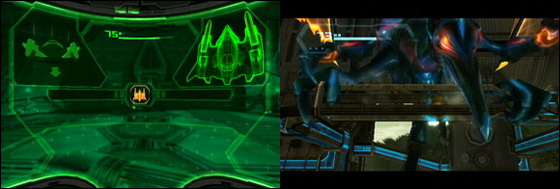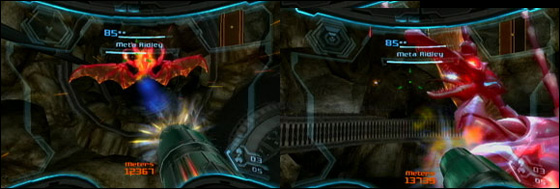Metroid Prime 3: Quarterly Diaries #1
September 29th, 2009

For the prelude to this article, please click here. I’m going to be jumping a lot between fully fledged observations rather than writing in a progressive walkthrough format as I originally proposed. So it’s more like; this topic was relevant at this part of the game, and up to now here are my thoughts on this relevant topic. I also intend to talk predominately about the pragmatic features of the game, rather than the actual goings-on (ie. what you do, what happens in the narrative). This post has evolved into something else entirely, so I’ve broken it into two. The next one will arrive shortly.
Areas Covered: Samus’ Ship, Olympus Space Station, Norion
Discussion Points: Samus’ Ship functionality, the extended cast, the tutorial functions, interplay with the cast, grapple lasso, Meta Ridley
Samus’ Ship
You begin Metroid Prime 3 in the cockpit of Samus’ spaceship. Interfacing with Samus’ ship is one of the new features to Metroid Prime 3, so using it as an initial starting point was probably a wise decision. Effectively it’s meant to act as the centre point of the game’s hub in which Samus can planet-hop through the galaxy, but due to the limited destinations it initially doesn’t present itself in such a manner and feels largely worthless. Most of the ship’s utilities seem pretty immaterial too. Oh, that is besides the cool gimmicks, of course.
Olympus Space Station
Samus soon departs to the Olympus space station. This is an interesting area because it’s unusually full of people. I don’t mean literally full of people, they’re actually pretty sparse and don’t really converse anything of merit – but people, in a Metroid game. It’s a little bizarre. The Metroid games have always been about isolation and Metroid Prime 3‘s attempt to branch out into, both the figurative and literal, social sphere of the universe is an awkward fit. What are all you stand-in space folk doing in my Metroid game? Shoo! The space station, just like the ship, rather quickly familiarizes players with these new, superfluous additions. That isn’t to be too discrediting though. Retro Studios, so far (as in 25% progression), has done an admirable job at handling them, but that doesn’t prevent these features from providing unnecessary friction against the rest of the game.

I’m hesitant to say whether Olympus Space Station acts as the game’s tutorial or not. It isn’t until after the events on Norion where the game properly begins. It’s akin to Metal Gear Solid 3 in this regard, the Virtuous Mission is obviously the tutorial, but the game doesn’t really open until after the Ocelot battle once you’ve retraced your footsteps – there’s a bit of suspension in between.
The space station more or less suits you up everything pre-MP3, whilst setting the precedence for the conflict. You learn the basics of moving, shooting and morph-balling, acquire missiles, meet some savage space pirates and down a boss. It’s not until after Norion that you’ll gain the PED suit and grapple lasso; the latest additions to the bounty hunter’s repertoire. Narrative-wise it’s the same, the Olympus Space Station sets the scene, Norion takes the next appropriate steps and acquaints you with the rival bounty hunters and the treacherous Dark Samus.
Norion
Norion is interesting as the primary objective (objectives are provided frequently by the Galactic Federation) is shared among Samus and the collective group of other bounty hunters. The team must reactivate three turret generators to fight off a wave of incoming space pirate fleets. One might assume that Samus, as the player, performs all the work for the team (as tends to be the case in most video games) but in actuality she completes her objective while frequently, and seamlessly, aiding the other members. There’s clear cross over as the other hunters interlude with your progress, passing the rod and covering your back. This gives Retro breathing room to introduce the various members as they portray their distinctive personalities. In later levels the bounty hunters become “corrupted”, forming the core boss encounters of the game. This initial method of introduction is clever then as it plants the seeds for what’s to come.

The grapple lasso is the key new mechanic for this isolated chapter of gameplay. The lasso is a perfect fit for Metroid Prime 3, made better by the tugging sensation from the Wii nunchuck. The lasso surprisingly lends itself to a host of action (not just rounding up space pirates, well ok, you can’t do that either) such as removing debris or ripping shields from space pirates. Very satisfying. The new visor for commanding Samus’ ship is also used briefly, I’m yet to be convinced though.

Near the end of the Norion level we’re spoilt by the appearance of Meta Ridley. He makes a brief stint as Samus is making her way to the final generator traveling through a metal frame in morphball-mode. Ridley clings onto the frame and tries to chew his way through. He’s just there to spook you though and it nicely crescendos into the next spate of space pirate attack and then finally into the proper confrontation with Ridley. This sequence is a little rough around the edges, but mostly achieves its desired sense of thrill. Firstly though, Ridley’s entrance is brilliant and if it wasn’t for it’s earlier showing in E3 demos, I would have probably been blown out of my seat. The boss situation is equally so, seeing Samus and Ridley in hot pursuit as they fall down a hazardous shaft. The execution is a little wonky as the battle plays out in two heavily controlled spaces; either falling face first, avoiding oncoming debris, or in the tight grip of Ridley’s claw. The transitions between each are a little awkward as the first person viewpoint tries to orientate itself around the action. It’s a little jarring but a momentous battle all the same.
Gameplay Images Taken From IGN Guides



 Game Design Companion: A Critical Analysis of Wario Land 4 - $7.99
Game Design Companion: A Critical Analysis of Wario Land 4 - $7.99 Level Design: Processes and Experiences
Level Design: Processes and Experiences Speed Boost: The Hidden Secrets Behind Arcade Racing Design - $5.99
Speed Boost: The Hidden Secrets Behind Arcade Racing Design - $5.99 Adventures in Games Analysis: Volume I - $5.99
Adventures in Games Analysis: Volume I - $5.99







